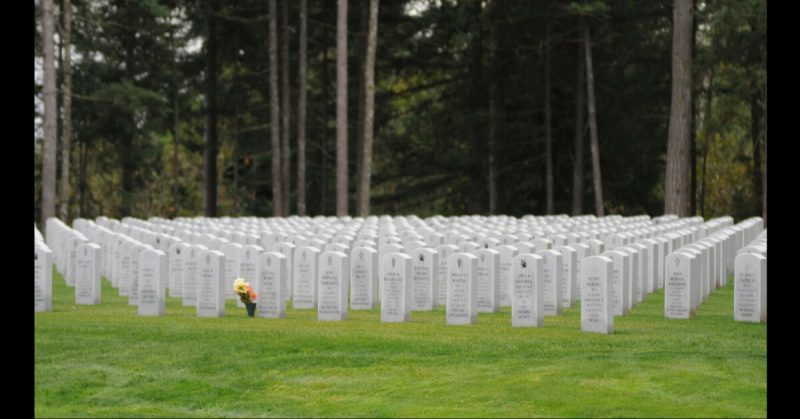Two men who were best friends enlisted together to serve in World War II. First Lt. Jim Louvier came home from that war. His friend, First Lt. Bill Gray did not make it back. For 73 years no one knew exactly what happened to him. Then, in 2016, his bones were found in the root of a tree. Louvier passed away in 2010 at the age of 89. The family could never figure out where to bury his ashes. Now, with Gray coming home, the choice is clear. The two men were buried with full military honors, side by side in Kent, Washington, at the Tahoma National Cemetery on July 14, 2017.
In April 1945, Gray’s plane crashed in Germany, but his remains were never found. He and his friend Louvier had made a pact that if one returned but the other did not, the surviving friend would take care of the other man’s family. Louvier honored that promise and married Gray’s sister. Their daughter, Jan Bradshaw, thought that her uncle would never be found.
The only items they had to remember Gray by were more than 100 letters he wrote home. In the last one, he mentioned that he had flown 68 missions.
Investigators who were searching for a different missing soldier were told about Gray’s crash by witnesses who were able to describe it in detail. With the help of the witnesses, the team was able to locate the place where Gray crashed, but they didn’t find Gray.
In 2016, crews excavated the site. Fifteen days into the search, they discovered that a tree had grown around his bones and they were now integrated into the roots of the tree. DNA of the bones matched his two sisters, and the remains were sent home to be buried.
Gray was a member of the 391st Fighter Squadron, 366th Fighter Group. He was flying a P-47D on a dive-bombing mission near Lindau, Sachsen-Anhalt, Germany. According to his flight leader, Gray strafed a truck and then clipped some trees with his left wing, causing him to crash.
Gray’s aircraft was recovered by the American Graves Registration Command in October 1948. They were able to correlate serial numbers on the plane with the plane Gray was known to be flying at the time of the accident. His remains were not found at that time.
In 2012, Joint POW/MIA Accounting Command (now the Defense POW/MIA Accounting Agency) investigators were contacted by witnesses and told where Gray’s crash site was. The investigators recommended excavating that location.
In April of 2016, the Defense POW/MIA Accounting Agency (DPAA) excavated the site and found Gray’s remains. They sent the remains to a DPAA lab for analysis. Researchers used anthropological analysis and historical research and analysis to help prove the remains belonged to Gray.
For his service, Gray was awarded the Distinguished Flying Cross, the Air Medal with 6 Oak Leaf Clusters and the Purple Heart.
Of the 16 million Americans who served in the war, more than 400,000 were killed. There are still over 73,000 missing.
Louvier served as a bomber co-pilot. He returned to Washington in September of 1945. On November 24, 1945, he married Gray’s sister, Jeanne, and remained married to her for nearly 65 years before he passed away in 2010. He worked as an electrician, eventually becoming the owner of Yansen Electric. He became an electrical inspector for the state of Washington in the 70s and retired in 1984 as the chief of the mobile and modular division.
